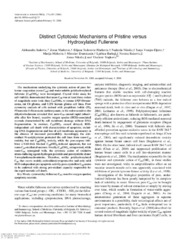Приказ основних података о документу
Distinct cytotoxic mechanisms of pristine versus hydroxylated fullerene
| dc.creator | Isaković, Aleksandra J. | |
| dc.creator | Marković, Zoran M. | |
| dc.creator | Todorović-Marković, Biljana | |
| dc.creator | Nikolić, Nadežda S. | |
| dc.creator | Vranješ-Đurić, Sanja | |
| dc.creator | Mirković, Marija D. | |
| dc.creator | Dramićanin, Miroslav | |
| dc.creator | Harhaji, Ljubica M. | |
| dc.creator | Raičević, Nevena | |
| dc.creator | Nikolić, Zoran M. | |
| dc.creator | Trajković, Vladimir S. | |
| dc.date.accessioned | 2018-03-01T19:47:45Z | |
| dc.date.available | 2018-03-01T19:47:45Z | |
| dc.date.issued | 2006 | |
| dc.identifier.issn | 1096-6080 | |
| dc.identifier.uri | https://vinar.vin.bg.ac.rs/handle/123456789/3002 | |
| dc.description.abstract | The mechanisms underlying the cytotoxic action of pure fullerene suspension (nano-C-60) and water-soluble polyhydroxylated fullerene [C-60(OH)(n)] were investigated. Crystal violet assay for cell viability demonstrated that nano-C-60 was at least three orders of magnitude more toxic than C-60(OH)(n) to mouse L929 fibrosarcoma, rat C6 glioma, and U251 human glioma cell lines. Flow cytometry analysis of cells stained with propidium iodide (PI), PI/annexin V-fluorescein isothiocyanate, or the redox-sensitive dye dihydrorhodamine revealed that nano-C-60 caused rapid (observable after few hours), reactive oxygen species (ROS)-associated necrosis characterized by cell membrane damage without DNA fragmentation. In contrast, C-60(OH)(n) caused delayed, ROS-independent cell death with characteristics of apoptosis, including DNA fragmentation and loss of cell membrane asymmetry in the absence of increased permeability. Accordingly, the antioxidant N-acetylcysteine protected the cell lines from nano-C-60 toxicity, but not C-60(OH)(n) toxicity, while the pan-caspase inhibitor z-VAD-fmk blocked C-60(OH)(n)-induced apoptosis, but not nano-C-60-mediated necrosis. Finally, C-60(OH)(n) antagonized, while nano-C-60 synergized with, the cytotoxic action of oxidative stress-inducing agents hydrogen peroxide and peroxynitrite donor 3-morpholinosydnonimine. Therefore, unlike polyhydroxylated C-60 that exerts mainly antioxidant/cytoprotective and only mild ROS-independent pro-apoptotic activity, pure crystalline C-60 seems to be endowed with strong pro-oxidant capacity responsible for the rapid necrotic cell death. | en |
| dc.relation | info:eu-repo/grantAgreement/MESTD/MPN2006-2010/145073/RS// | |
| dc.rights | openAccess | en |
| dc.source | Toxicological Sciences | en |
| dc.subject | cytotoxicity | en |
| dc.subject | fullerene | en |
| dc.subject | C60 reactive oxygen species | en |
| dc.subject | apoptosis | en |
| dc.subject | necrosis | en |
| dc.title | Distinct cytotoxic mechanisms of pristine versus hydroxylated fullerene | en |
| dc.type | article | en |
| dc.rights.license | ARR | |
| dcterms.abstract | Исаковиц, A; Николиц, Н; Хархаји, Л; Марковић Зоран; Тодоровић-Марковић Биљана; Врањеш-Дјурић Сања; Мирковић Марија; Драмићанин Мирослав; Раичевић Невена; Николиц, З; Трајковиц, В; | |
| dc.citation.volume | 91 | |
| dc.citation.issue | 1 | |
| dc.citation.spage | 173 | |
| dc.citation.epage | 183 | |
| dc.identifier.wos | 000236808200020 | |
| dc.identifier.doi | 10.1093/toxsci/kfj127 | |
| dc.citation.rank | M21 | |
| dc.identifier.pmid | 16476688 | |
| dc.type.version | publishedVersion | |
| dc.identifier.scopus | 2-s2.0-33645806308 | |
| dc.identifier.fulltext | https://vinar.vin.bg.ac.rs//bitstream/id/12361/2998.pdf |

